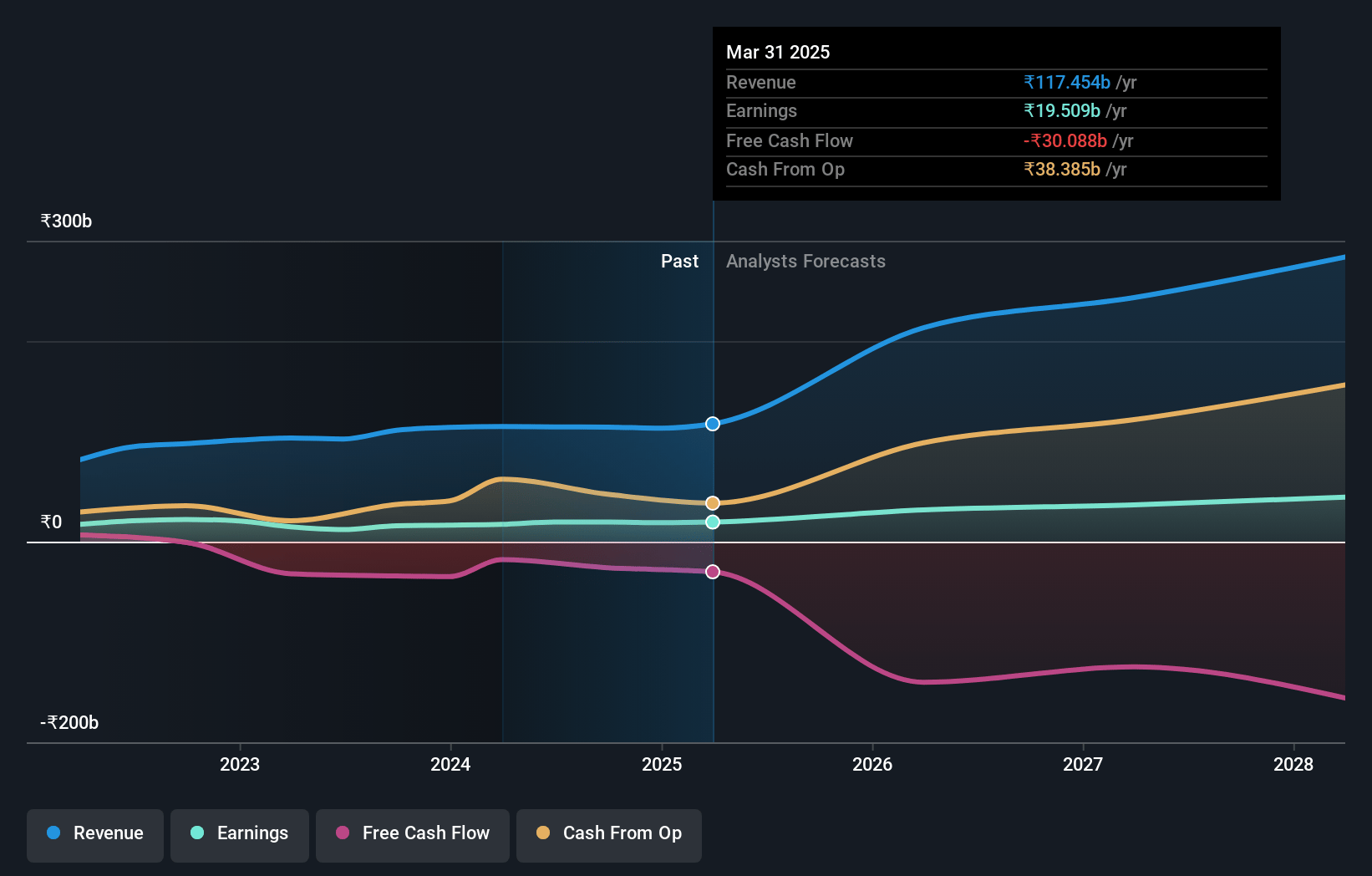Narratives are currently in beta
Key Takeaways
- Strategic acquisitions and renewable expansions are set to boost JSW Energy's revenue and profitability through enhanced capacity and cash flows.
- Emphasis on hybrid energy solutions and efficient capital expansion promises improved margins and operational efficiencies.
- Increased financial leverage and regulatory challenges, along with cost pressures, could hinder JSW Energy's revenue growth and margin sustainability.
Catalysts
About JSW Energy- Generates and sells power in India.
- The acquisition of O2 Power is expected to significantly enhance JSW Energy's renewable energy portfolio and provide substantial capacity additions, potentially increasing revenue due to the high-quality, long-term PPA arrangements.
- JSW Energy's strategic acquisition of KSK Mahanadi, a large thermal power plant, is expected to generate immediate cash flows and improve earnings due to its strategic location and existing fuel supply agreements.
- The ongoing expansion with a target to reach 20 gigawatts by FY '30, and with a long-term locked-in capacity of 28.3 gigawatts, is likely to drive future revenue growth.
- The growing emphasis on hybrid solutions and energy storage, aligned with JSW's strategic moves in such projects, is expected to bolster profitability, enhancing net margins by providing higher value solutions.
- The relatively lower forward CapEx requirements for expanding existing acquisitions compared to greenfield projects are expected to improve net margins by reducing per unit capital costs and enhancing operational efficiencies.
JSW Energy Future Earnings and Revenue Growth
Assumptions
How have these above catalysts been quantified?- Analysts are assuming JSW Energy's revenue will grow by 27.4% annually over the next 3 years.
- Analysts assume that profit margins will increase from 16.7% today to 18.8% in 3 years time.
- Analysts expect earnings to reach ₹44.0 billion (and earnings per share of ₹26.3) by about January 2028, up from ₹18.9 billion today. However, there is a considerable amount of disagreement amongst the analysts with the most bullish expecting ₹49.0 billion in earnings, and the most bearish expecting ₹20.6 billion.
- In order for the above numbers to justify the analysts price target, the company would need to trade at a PE ratio of 35.6x on those 2028 earnings, down from 43.6x today. This future PE is greater than the current PE for the IN Renewable Energy industry at 25.9x.
- Analysts expect the number of shares outstanding to decline by 1.4% per year for the next 3 years.
- To value all of this in today's terms, we will use a discount rate of 12.81%, as per the Simply Wall St company report.
JSW Energy Future Earnings Per Share Growth
Risks
What could happen that would invalidate this narrative?- The acquisition of O2 Power and the significant CapEx required for its projects, combined with the debt from the KSK Mahanadi acquisition, could lead to increased leverage. This might affect net margins due to higher interest costs.
- The flat revenue despite increased generation indicates potential issues with pricing power or increased competition, which can affect future revenues and profit margins.
- The order from CERC not allowing tariff adoption for JSW Energy's battery energy storage project raises concerns about regulatory challenges, which could impact revenue from new storage initiatives.
- The company has a weighted average interest cost that has increased due to annual resets and increased MCLR, which could lead to higher future finance costs affecting net earnings.
- Delays or challenges in land acquisition or transmission connectivity for new renewable projects might slow capacity additions, impacting projected revenue growth and earnings targets in the medium term.
Valuation
How have all the factors above been brought together to estimate a fair value?- The analysts have a consensus price target of ₹651.83 for JSW Energy based on their expectations of its future earnings growth, profit margins and other risk factors. However, there is a degree of disagreement amongst analysts, with the most bullish reporting a price target of ₹885.0, and the most bearish reporting a price target of just ₹370.0.
- In order for you to agree with the analyst's consensus, you'd need to believe that by 2028, revenues will be ₹234.1 billion, earnings will come to ₹44.0 billion, and it would be trading on a PE ratio of 35.6x, assuming you use a discount rate of 12.8%.
- Given the current share price of ₹473.25, the analyst's price target of ₹651.83 is 27.4% higher.
- We always encourage you to reach your own conclusions though. So sense check these analyst numbers against your own assumptions and expectations based on your understanding of the business and what you believe is probable.
How well do narratives help inform your perspective?
Disclaimer
Warren A.I. is a tool utilizing a Large Language Model (LLM) that ingests data on consensus price targets, forecasted revenue and earnings figures, as well as the transcripts of earnings calls to produce qualitative analysis. The narratives produced by Warren A.I. are general in nature and are based solely on analyst data and publicly-available material published by the respective companies. These scenarios are not indicative of the company's future performance and are exploratory in nature. Simply Wall St has no position in the company(s) mentioned. The price targets and estimates used are consensus data, and do not constitute a recommendation to buy or sell any stock, and they do not take account of your objectives, or your financial situation. Note that Warren A.I.'s analysis may not factor in the latest price-sensitive company announcements or qualitative material.
Read more narratives
There are no other narratives for this company.
View all narratives



